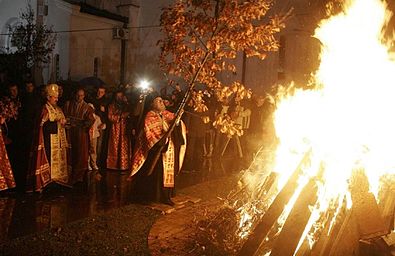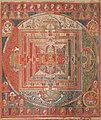Portal:Religion
The Religion Portal
Religion is a range of social-cultural systems, including designated behaviors and practices, morals, beliefs, worldviews, texts, sanctified places, prophecies, ethics, or organizations, that generally relate humanity to supernatural, transcendental, and spiritual elements—although there is no scholarly consensus over what precisely constitutes a religion. Different religions may or may not contain various elements ranging from the divine, sacredness, faith, and a supernatural being or beings. (Full article...)
 Vital article
Vital article
Theravāda (/ˌtɛrəˈvɑːðə/; lit. 'School of the Elders'; Chinese: 上座部佛教; Vietnamese: Thượng tọa bộ) is the most commonly accepted name of Buddhism's oldest existing school. The school's adherents, termed Theravādins (anglicized from Pali theravādī), have preserved their version of Gautama Buddha's teaching or Dhamma in the Pāli Canon for over two millennia. (Full article...)
 Did you know (auto-generated)
Did you know (auto-generated)
- ... that a religious community is a group of people who practice the same religion, but do not have to live together?
- ... that the nonconformist minister Ichabod Chauncey was banished from England under the Religion Act 1592 and spent two years in exile in Holland where he published a defence of his actions?
- ... that Gherardo Gambelli, the incoming archbishop of Florence, served as a prison chaplain in Chad for over a decade?
- ... that the capital of South Ossetia once had more Jews than Ossetians?
- ... that religious studies scholar C. Jouco Bleeker believed that religions are like acorns?
- ... that fictional religions, often described in speculative fiction, have in some cases inspired real religious movements?

The badnjak (Serbian Cyrillic: бадњак, pronounced [bǎdɲaːk]), also called veseljak (весељак, pronounced [ʋɛˈsɛ̌ʎaːk], literally "the one who brings joy" in Serbian), is a tree branch or entire tree that is central to Serbian Christmas celebrations. It is placed on a fire on Christmas Eve and its branches are later brought home by worshipers. The tree from which the badnjak is cut, preferably a young, straight and undamaged oak, is ceremonially felled early on the morning of Christmas Eve. The felling, preparation, bringing in, and laying on the fire, are surrounded by elaborate rituals, with many regional variations. The burning of the log is accompanied by prayers that the coming year brings food, happiness, love, luck, and riches. The log burns on throughout Christmas Day, when the first visitor strikes it with a poker or a branch to make sparks fly, while wishing that the family's happiness and prosperity be as abundant as the sparks. As most Serbs today live in towns and cities, the badnjak is often symbolically represented by a cluster of oak twigs with brown leaves attached, with which the home is decorated on Christmas Eve. (Full article...)


































































